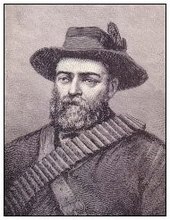Piet Cronjé
Pieter Arnoldus Cronjé (born October 4, 1836 in Colesberg , Cape Colony ; † February 4, 1911 in Potchefstroom , Transvaal ), known as Piet Cronjé , was a commander of the Boers in the First and Second Boer Wars .
Life
Cronjé was born in the British Cape Colony, but grew up in the Boer-ruled South African Republic .
In 1880 he started a rebellion against British troops. The trigger was a farmer whose goods were taken away because he had not paid any taxes. In the First Boer War that followed, he was in command and successfully besieged the British garrison in Potchefstroom. In 1881, in the course of regaining independence, he became a member of the Volksraad of the South African Republic and supported Paul Kruger .
Cronjé was in command of the soldiers who surrounded the British Leander Starr Jameson and his troops at the end of the Jameson Raid on January 2, 1896 at Doornkop . During the Second Boer War, Cronjé was general and commanded the western part of the Boer troops. He started the sieges of Kimberley and Mafeking . In Mafeking he besieged the 1,200 soldiers and members of the militia under Colonel Robert Baden-Powell with 2,000 to 6,000 soldiers .
The British commander Lord Methuen wanted to end the siege of Kimberley. On November 28, 1899, his troops fought the Boers in the Battle of Modder River . The battle ended in a Pyrrhic victory for the British. Cronjé first used the tactic of positioning the infantry on the banks of the river instead of on the hills in order to make better use of the elongated trajectories of the Mauser rifles. The idea came from the Boer general Koos de la Rey . Cronjé later defeated the British forces under Lord Methuen at the Battle of Magersfontein on December 11, 1899.
Cronjé withdrew his troops to the east. However, he was defeated at the Battle of Paardeberg and surrendered on February 27, 1900 with 3,919 soldiers - almost a tenth of Boer troops - after being encircled by Lord Roberts' forces. Cronjé and his wife Hester, who had accompanied him into battle, were taken to the British Atlantic island of St. Helena as prisoners of war along with around 1,000 other Boers , where he remained imprisoned until the peace agreement in 1902.
Cronjé lived in Klerksdorp for the last years of his life .
Web links
- Entry in the Encyclopædia Britannica (English)
Individual evidence
- ^ Martin Meredith: Diamonds, Gold, and War: The British, the Boers, and the Making of South Africa . PublicAffairs, 2008, pp. 99-100.
- ↑ a b c Entry at britannica.com (English), accessed on January 29, 2014
- ^ Carl Hodge: Encyclopedia of the Age of Imperialism, 1800-1914 . Greenwood Publishing Group, 2008, p. 89.
- ↑ George Usher: Dictionary of British Military History . A&C Black, 2009.
- ↑ Information at sahistory.org.za , accessed on January 30, 2014
- ^ Ian Knight: Boer Commando 1876-1902 . Osprey Publishing, 2004, p. 56.
| personal data | |
|---|---|
| SURNAME | Cronjé, Piet |
| ALTERNATIVE NAMES | Cronjé, Pieter Arnoldus |
| BRIEF DESCRIPTION | Boer general |
| DATE OF BIRTH | October 4, 1836 |
| PLACE OF BIRTH | Colesberg |
| DATE OF DEATH | February 4, 1911 |
| Place of death | Potchefstroom |

